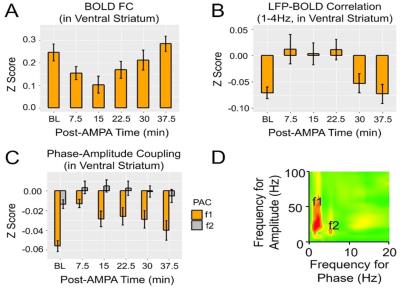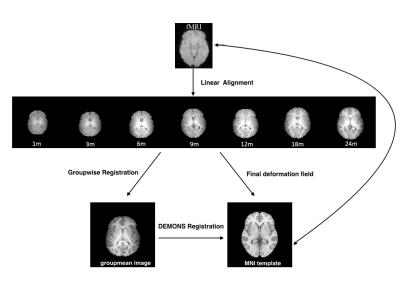Poster: Cutting Edge fMRI
Electronic Power Pitch Poster
fMRI
Monday, 24 April 2017
| Exhibition Hall |
17:15 - 18:15 |
| |
|
Plasma # |
 |
0237.
 |
1 |
Cortical depth-dependent fMRI: heterogeneity across tasks, across participants, across days and along the cortical ribbon 
Laurentius Huber , Daniel Handwerker, Andrew Hall, David Jangraw, Javier Gonzalez-Castillo, Maria Guidi, Dimo Ivanov, Benedikt Poser, Peter Bandettini
Measurements of depth-dependent cortical activity provide insights on directional activity between brain areas. While previous studies demonstrated the feasibility of human depth-dependent fMRI, the stability and reliability of depth-dependent results are less studied. In this work, we investigate sources of inconsistencies in depth-dependent activity profiles. We find that depth-dependent activity profiles are highly reproducible across different scanning sessions. They are, however, quite variable within cortical areas across different cross sections along the cortical ribbon. Only when depth-dependent profiles are considered with respect to their location along the cortical ribbon, task-driven modulations of input-output activity become consistent across participants.
|
|
0238.
 |
2 |
Simultaneous GCaMP6 based fiber photometry and fMRI in rats 
Zhifeng Liang, Yuncong Ma, Nanyin Zhang
Measuring neural activities simultaneously with fMRI using electrophysiology approaches has been valuable in elucidating neural basis of BOLD signals, but is also technically challenging due to interferences from MRI scanners. Optical recording of neural activities such as calcium signals has minimal interferences from MRI, and thus has opened new avenues of simultaneous acquisition of neural and BOLD signals. The current study first demonstrated the feasibility of using protein based calcium indicator (GCaMP6) to simultaneously and repeatedly acquire calcium and BOLD signals in the MRI scanner, with significant increases of both signals in response to visual stimulation.
|
 |
0239.
 |
3 |
Optogenetic resting-state fMRI reveals thalamic modulation of long-range sensory networks 
Alex T. L. Leong, Xunda Wang, Russell W. Chan, Leon C. Ho, Yongrong Qiu, Celia M. Dong, Ed X. Wu
One grand challenge in contemporary neuroscience is to achieve an integrated understanding of large-scale brain-wide networks. Resting-state functional MRI (rsfMRI) has helped reveal such brain-wide networks, yet, the neural bases underlying them remain unclear. Utilizing optogenetic excitation and pharmacological inactivation to manipulate the neural activity of somatosensory thalamocortical neurons, the present study demonstrated that rsfMRI connectivity is enhanced and decreased respectively. Furthermore, our findings suggest that optogenetically-evoked propagating low frequency activity (~1Hz) within the thalamo-cortico-thalamic network facilitate the enhancement of rsfMRI connectivity. Our work offers an exciting avenue to dissect the underlying neural bases of brain-wide functional connectivity.
|
|
0240.
 |
4 |
Global signal regression alters the correlation between resting-state BOLD fluctuations and EEG vigilance measures 
Maryam Falahpour, Alican Nalci, Chi Wah Wong, Thomas Liu
Global signal regression (GSR) is a commonly used preprocessing approach in the analysis of resting state fMRI data. Utilizing simultaneously acquired EEG/fMRI data in humans, we found that GSR alters the correlation between the resting-state BOLD fluctuations and EEG vigilance. We show that GSR reveals BOLD-EEG correlations that are otherwise obscured and use a time segmentation approach to argue that the observed effects are not simply an artifact of GSR.
|
|
0241.
 |
5 |
What is the neurophysiological bases of resting state functional connectivity? 
Hanbing Lu, Saul Jaime, Elliot Stein, Jose Cavazos, Yihong Yang
Despite wide application of resting state functional connectivity (rsFC) in systems neuroscience, fundamental aspects of rsFC remain poorly understood. Concurrent multi-channel electrophysiological recording and fMRI were performed in rat striatum along with pharmacological manipulation of VTA dopamine neuronal activity. Results suggest that LFPs of different frequency bands contribute distinctively and differentially to the observed BOLD fluctuations, and that cross-frequency phase-amplitude coupling (PAC) is the organizing mechanism through which low frequency LFPs orchestrate neural activity that underlies the BOLD rsFC. Our data imply that where there is a synchronized low frequency LFP signal, there is also resting state BOLD functional connectivity. rsFC does not necessarily reflect structural connectivity.
|
|
0242.
 |
6 |
Functional Neuroimaging in the Brain using Magnetic Resonance Elastography 
Samuel Patz, Navid Nazari, Paul Barbone, Ben Fabry, Dan Fovargue, David Nordsletten, Ralph Sinkus
Using electrical stimulation of the hind limb, Magnetic Resonance Elastography (MRE) was used to observe localized changes in the complex shear modulus G=G’ + iG’’ of the mouse brain cortex. “Stimulation” and “no stimulation” paradigms were alternated every 10s to avoid habituation. An average increase of ~14% in G’ was observed whereas no significant change was seen for G’’. The effect was observed in six of seven mice studied. The mechanism responsible for this effect is hypothesized to be due to calcium influx into the neuronal cells.
|
|
0243.
 |
7 |
Fully Automated Learning based Method for resting state fMRI Connectomics Analysis - permission withheld
Arathi Sreekumari, Radhika Madhavan, Rakesh Mullick, Teena Shetty, Pratik Mukherjee, Joseph Masdeu, Luca Marinelli, Suresh Joel
Machine learning approaches are increasingly being used to identify discriminative features derived from functional connectome data that best separate a diseased group from healthy cohorts. Here, we propose a novel framework for longitudinal prediction of disease outcome, using a combination of unsupervised and supervised learning approaches. Using this framework, we achieve 81% accuracy for prediction of mild traumatic brain injury outcome at 3-months by learning features from functional connectomes at the acute stage of injury (<1 week).
|
|
0244.
 |
8 |
A Multiband Multi-Echo Simultaneous ASL/BOLD Acquisition for Resting State Functional Connectivity 
Alexander Cohen, Andrew Nencka, Yang Wang
A multiband multi-echo simultaneous ASL/BOLD sequence was developed and utilized to evaluate resting state connectivity. ASL sequences have inherently long TRs due to the tagging and delay components. To compensate for this, four echoes were collected allowing multi-echo independent component analysis (ME-ICA) to be employed to denoise the BOLD data. A seed-based analysis was used for the computation of functional connectivity. Temporal signal to noise ratio (tSNR) was significantly higher for the denoised data resulting in an increase in connectivity strength, cluster size, and number of clusters. The sequence also allowed perfusion-weighted connectivity to be computed.
|
|
0245.
 |
9 |
The first two years of whole brain functional development can be separated into three distinct time periods 
Weiyan Yin, Weili Lin
Resting functional connectivity has been utilized to characterize early brain functional development. Most of the studies to date have grouped subjects based on biological age, enabling assessment of brain functional maturation. However, this grouping approach assumes that subjects at the same age exhibit similar functional maturation, which may not be valid considering the paces of functional maturation could substantially vary among individuals. In this study, the normalized-Cut method was used to cluster connectivity matrixs of 71 normally developing children, 0 to 2 years of age, into distinct age periods (functional age) reflecting stable brain funcitonal connectivity. We found that brain functional development during the first two years of life consists of three distinct time periods 0 – 2, 3 – 6, and 7 - 26 months, respectively. In addition, 17 core brain regions were identified, which largely drove our clustering results. These regions could be of critical importance for early brain development.
|
|
0246.
 |
10 |
MRI Connectivity Predictors of Post-Surgical Seizure Outcome in Temporal Lobe Epilepsy 
Victoria Morgan, Dario Englot, Adam Anderson, Bennett Landman, Ahmet Cakir, Baxter Rogers, Bassel Abou-Khalil
Surgical resection of the mesial temporal lobe is a common treatment of drug-resistant temporal lobe epilepsy (TLE). The ability to more accurately predict post-surgical seizure outcome in these patients is a significant clinical challenge. Towards this end, MRI functional and structural connectivity were used to identify a common pattern across a seizure propagation network in TLE patients with seizure free outcome. Then, in test patients with good and bad outcomes, similarity with the model pattern was significantly associated with seizure outcome. Therefore, this non-invasive method may predict seizure outcomes in TLE, which was not possible from the clinical assessments alone.
|
 |
0247.
 |
11 |
CEST fMRI at ultra-high magnetic field 
Tangi Roussel, Lucio Frydman, Denis Le Bihan, Luisa Ciobanu
BOLD indirectly measures brain activity based on neurovascular coupling, a reporter which is naturally poor in both its spatial and temporal resolutions. Emerging methods involving spectroscopy (fMRS) and diffusion fMRI suggest that metabolic and structural modifications are taking place in the activated cells. In this paper, we introduce Chemical Exchange Saturation Transfer (CEST)-weighted fMRI as a new method to explore changes in rat brain activation at 17.2T. Monte Carlo simulations were performed to optimize the acquisition and processing methods. Experimentally, CEST-weighted fMRI activation maps showed negative contrast at +1.2ppm most likely originating from changes in the glucose metabolism.
|
 |
0248.
 |
12 |
EPI-signal fluctuations at the cardiac frequency: A tissue-specific quantification of inflow, displacement and potential oxygenation effects over the cardiac cycle. 
Olivia Viessmann, Peter Jezzard
The impact and transmission mechanisms of the cardiac arterial pressure wave into brain tissue are not fully understood. It is hypothesised that age-related arterial stiffening and increased CBF pulsatility leads to propagation of the arterial wave further down the vascular tree causing tissue damage. Here we quantify inflow ($$$S_0$$$) and displacement/oxygenation ($$$T_2^*$$$) induced fluctuations of the EPI-signal at the cardiac frequency. We relate the EPI-signal phase at the cardiac frequency to the fluctuations of $$$S_0$$$ and $$$T_2^*$$$ over the cardiac cycle in the arteries, veins and tissue.
|
|
0249.
 |
13 |
The global resting-state fMRI signal is associated with opposite changes at subcortical structures regulating arousal. 
Xiao Liu, Jacco de Zwart, David Leopold, Jeff Duyn
Spontaneous, large scale fluctuations (LSF) in neocortical fMRI activity may result from arousal variations. To investigate the role of arousal, we examined an fMRI database for local fMRI changes at subcortical arousal-regulating structures associated with widespread fMRI co-activations in the neocortex. We identified three subcortical regions that showed anti-polar signal changes with LSF. These regions, known for promoting wakefulness, included the Nucleus Basalis, the Dorsal Midline Thalamus, and the Substantia Nigra. This finding is further evidence of a putative role of arousal in LSF, and suggest that caution should be exercised when extracting functional connectivity measures from fMRI data.
|
|
0250.
 |
14 |
Functional connectivity is globally altered by schizophrenia-linked genes 
Garth Thompson, Karen Perez De Arce, Basavaraju Sanganahalli, Stephen Strittmatter, Thomas Biederer, Fahmeed Hyder
Resting state fMRI shows increased global synchrony in schizophrenia at rest, but mechanisms remain speculative. We tested mice with knockout of SynCAM1 (related to synaptic organization), LRRTM1 (related to schizophrenia symptoms) and both genes using whisker-stimulation and resting-state fMRI. SynCAM1 was linked to stronger whisker barrel activation and to greater functional connectivity. However, this was lost if global signal regression was performed. Global signal amplitude was significantly higher in SynCAM1 knockout mice, and amplified by the additional knockout of LRRTM1. We hypothesize this is due to disrupted synaptic connections by SynCAM1 knockout, which are partially protected when LRRTM1 is present.
|
|
0251.
 |
15 |
Population Receptive Field Mapping of Human Somatosensory Cortex at 7 T 
Michael Asghar, Rosa Sanchez-Panchuelo, Denis Schluppeck, Susan Francis
To advance the investigation of function and structure in human somatosensory areas, detailed topographic maps that are reproducible across time are invaluable. In previous 7 Tesla fMRI studies using travelling wave (TW) and event-related (ER) paradigms, the functional parcellation of digit representations in human S1 has been shown. Here, we present the application of ‘population Receptive Field’ analysis (pRF) to high-resolution fMRI data from somatosensory cortex. The pRF method can provide information beyond preferred stimulus location, such as measures of receptive field size. We also show how surface coils can be used to improve spatial resolution in somatotopic maps.
|
|
 Power Pitches Video
Power Pitches Video















